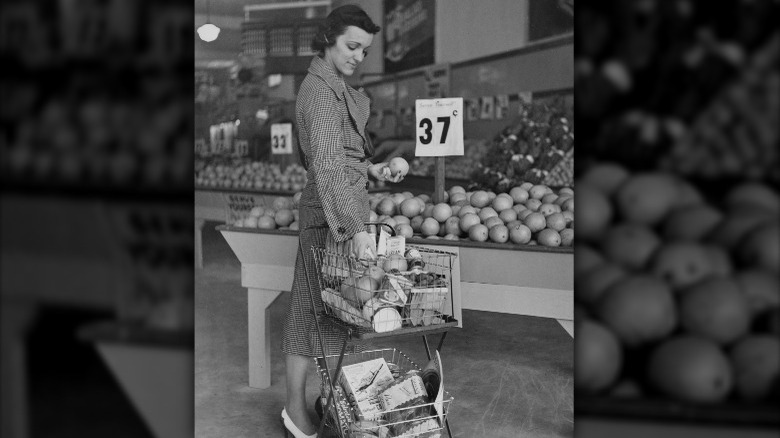Our Shiny New 2-Tier Shopping Carts Are Actually From The 1930s
When it comes to groceries, people tend to spend more time mulling over the origins of their food than the cart they use to shop for it. It's only fair — obviously, a shopping cart won't ever be found on the end of a fork. But little is left to chance when it comes to how we gather food at the store. The dairy aisle is deliberately located far away from the supermarket's doors to encourage you to roam the store. Brands spend big bucks to place products clad in cartoons back-breakingly low on store shelves for kids to see and plead for. Even the shopping cart is designed to impact how much you buy, whether you're wheeling around a big one-basket cart or one of the compact two-tier carts. And while the second is new to many shoppers, especially since it isn't available at all supermarkets, it's actually a lot older than you might expect.
Often referred to online as the "millennial shopping cart," the two-tier shopping cart was invented in 1937 to accommodate the rise of supermarkets, which carried more products than conventional grocery stores. Instead of a handheld basket, the wheeled cart featured two baskets stacked on top of each other. This two-tier shopping cart was more convenient, portable, and, most importantly, able to hold more items. Many shoppers today prefer the design, which eventually evolved into the even larger, single-basket cart, but it wasn't an instant hit in the 1930s. Here's how its success came to fruition.
The first shopping cart rolled into stores in 1937
Amid the economic depression, the 1930s were ripe for innovation. During the decade, electric refrigeration took off, frozen foods became more widely available, and stores grew in size and scale. But as more goods became available, handheld baskets couldn't accommodate everything that people wanted to purchase. So, as the landscape of grocery shopping changed, the methods of navigating it did too.
After his first foray into wholesale produce went belly-up in the 1920s, grocery store owner Sylvan Goldman studied grocery retailers in California. He returned to his home state of Oklahoma to start a self-service chain with woven baskets so customers could shop freely. By the mid-1930s, he owned half of the Piggly Wiggly chain, the first modern grocery store. But Sylvan still sought to improve the grocery shopping experience, committed to increasing how much people could carry — and buy. Inspired by a folding chair, he designed the two-tier shopping cart with mechanic Fred Young in 1937. The wheeled cart featured two wire baskets suspended above one another with a metal frame.
Goldman expected the carts to be immediately popular, but shoppers didn't like them. Men felt they'd look weak using them; women felt they were too similar to the baby strollers they were tired of pushing around. But the initial resistance was easily influenced away. Goldman hired fake shoppers to push the carts around the store, encouraging real shoppers to use them. By the 1940s, the shopping cart became mainstream — and it's evolved a great deal since.
The evolution of the modern-day shopping cart
Since their invention, shopping carts have changed quite a bit as people set out to improve the original design. In 1946, Orla Watson introduced the rear swinging panel that allows carts to fit into each other, saving storage space and making shopping cart attendants' lives much easier. In 1968, Elmer Isaacks invented the first locking wheel design using magnets to prevent shopping carts from being stolen off store property. In 1982, Paul Giampavolo created the first shopping cart seat belt so children didn't fall out as their parents shopped. Still, one of the most obvious changes has been the increased size of shopping carts.
While the original model remains standard, most modern-day carts are massive. These large baskets have expanded for the same reason Sylvan Goldman first invented the shopping cart: To hold more. However, profit, rather than convenience, is perhaps the primary motivator nowadays. The more shoppers can put inside, the more they'll spend. This finding is well-supported in an experiment highlighted by TODAY, which revelead that when the size of shopping carts is doubled, people buy 40% more.
Although these large baskets are necessary at warehouse-sized wholesalers like Costco, many shoppers at regular supermarkets opt for the original two-tiered cart when possible. Its compact size makes it easier to navigate crowded aisles and spend less. And with the painfully high price of groceries, it's easy to see why many people are keen to wheel around a smaller cart.


